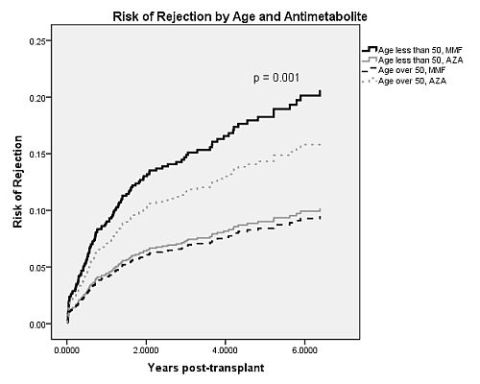Age and Antimetabolites: Appropriate Candidate Selection Drives Success
Pharmacy, Barnes-Jewish Hospital, St. Louis, MO
Medicine, Washington University, St. Louis, MO
Meeting: 2013 American Transplant Congress
Abstract number: D1584
Background:Early studies comparing mycophenolate (MMF) to azathioprine (AZA) post-renal transplant demonstrated superiority of MMF over AZA for the prevention of acute rejection (AR), with no difference in patient and graft loss, GFR, or safety. Further analyses have demonstrated differences in efficacy based on recipient age. Dose reductions of MMF due to adverse effects are common, increasing the incidence of AR and graft loss. We switch patients from MMF to AZA due to GI toxicity regardless of the time post-transplantation.
Methods:We analyzed kidney recipients transplanted 1/2002 – 12/2010, receiving rATG. They were classified into groups based on their age (>50) and use of AZA or MMF at discharge. Risk of AR was calculated using Cox-regression with multiple covariates.
Results:1109 patients were included, baseline characteristics are in table 1.
| Age < 50, MMF (N = 437) | Age < 50, AZA (N = 60) | Age > 50, MMF (N = 549) | Age > 50, AZA (N = 63) | p Val | |
| Male Sex % | 61.3 | 65.0 | 61.0 | 58.7 | 0.911 |
| Caucasian Race % | 72.3 | 83.3 | 74.7 | 93.7 | 0.008 |
| Delayed Graft Function % | 6.6 | 8.3 | 7.3 | 4.8 | 0.848 |
| Tacrolimus Use % | 95.9 | 66.7 | 96.0 | 68.3 | <0.001* |
| HLA Mismatches mean(SD) | 3.6 (1.6) | 3.3 (1.5) | 3.6 (1.7) | 3.6 (1.7) | 0.093 |
Overall, 126 (11.4%) experienced AR. Younger patients on MMF experienced the most AR episodes (16%) and older patients on MMF had the fewest (7.5%), while older patients on AZA had a higher risk of AR (14.3%) compared to younger (10.0%); these differences were significant (p<0.001). When correcting for race, tacrolimus use, delayed graft function, and HLA mismatches, the AZA/age groups remained significant (p=0.001).

No other predictors significantly influenced AR, but tacrolimus (p=0.054), Caucasian race (p=0.068), and HLA mismatches (0.062) trended towards significance. Leucopenia tended to be more frequent in older patients on AZA (17.7 vs 12.7%, p=0.33).
Conclusions: Azathioprine in younger patients is associated with a lower rate of AR than MMF, and is associated with higher rates of AR in older patients. This may be because older patients do not tolerate AZA as well and require dose reductions.
To cite this abstract in AMA style:
Horwedel T, Brennan D, Bowman L. Age and Antimetabolites: Appropriate Candidate Selection Drives Success [abstract]. Am J Transplant. 2013; 13 (suppl 5). https://atcmeetingabstracts.com/abstract/age-and-antimetabolites-appropriate-candidate-selection-drives-success/. Accessed December 22, 2025.« Back to 2013 American Transplant Congress
